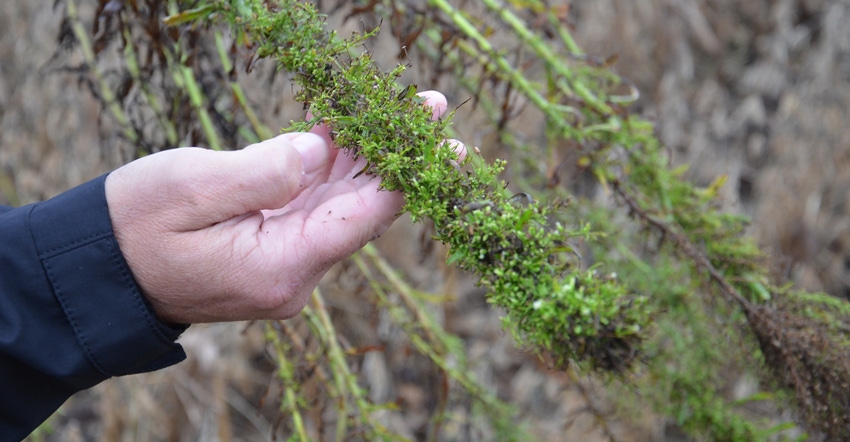
Steve Gauck visited the Soybean Watch ’17 field many times this summer, typically in 10-day to two-week intervals. The Beck’s agronomist enjoyed the chance to scout soybeans when he wasn’t coming to look for a specific problem.
Gauck soon found he was watching more than soybean development when he visited the field. Besides looking for slugs, taking stand counts and examining soybeans for signs of disease and insect feeding, he was paying attention to other plants growing in the field. “There were Canada thistles in spots, and there were also some marestail plants,” he says.
The problem began when it stayed wet after planting, which had already been delayed by wet weather. The grower couldn’t get back into the field to make a herbicide application when he wanted to do so. The field received more than 6 inches of rain in one day in July, further pushing back the final postemergence application.
“When he finally could make the application, he did a good job,” says Gauck, who is based near Greensburg, Ind. Soybean Watch ’17 is sponsored by Beck’s.
The farmer really did a number on the thistles, Gauck notes. There was slight bronzing of leaves on soybeans from the application, but Gauck believes that was a nonfactor in yield potential. As new leaves grew out, the remaining bronzed leaves simply marked the size the beans were when the field was spayed.
Marestail’s revenge
One thing Gauck watched all season was how singular marestail plants that escaped control in the spring reacted once sprayed during the late post-season application. “They had good size by then,” he says. “The spray burnt off the top growth, but it was soon obvious that it didn’t kill most of them.”
On subsequent visits, Gauck would find marestail plants in various stages of regrowth. On one plant, the center stem was destroyed, but it put out branches that greened up again. On another occasion, he found a plant where the bottom half was dead, but new growth started partway up the main stem.
Late in the season as the soybeans matured, Gauck found a marestail plant that had not only put on new green growth at the top of the plant, but that was also forming seed. “Depending upon when a killing freeze came, those seeds could have become viable,” he notes. “There weren’t tons of marestail plants which survived or went that far. The point is more recognizing that these plants have the ability to be that tough, and to survive herbicide applications and still grow and possibly even produce seed.”
What it means long term, Gauck believes, is that it pays to do whatever it takes to control marestail while it is small. That may mean a fall herbicide application if the weather allows it. It may also mean an effective burndown applied at the right time and at the right rate in the spring.
There are some reports that cereal rye helps suppress marestail. If you’re in a no-till system and use cover crops, it’s worth noting how much it helps. However, weed specialists say you will still need herbicides for seasonlong control, even if cereal rye helps suppress marestail early.
About the Author(s)
You May Also Like




